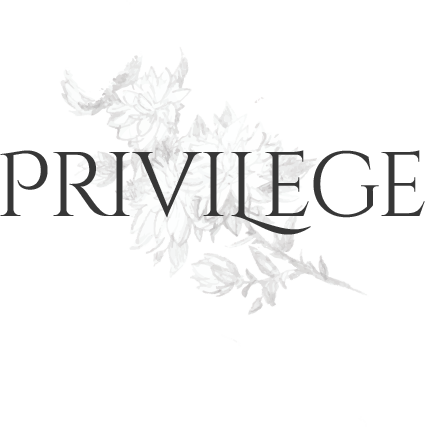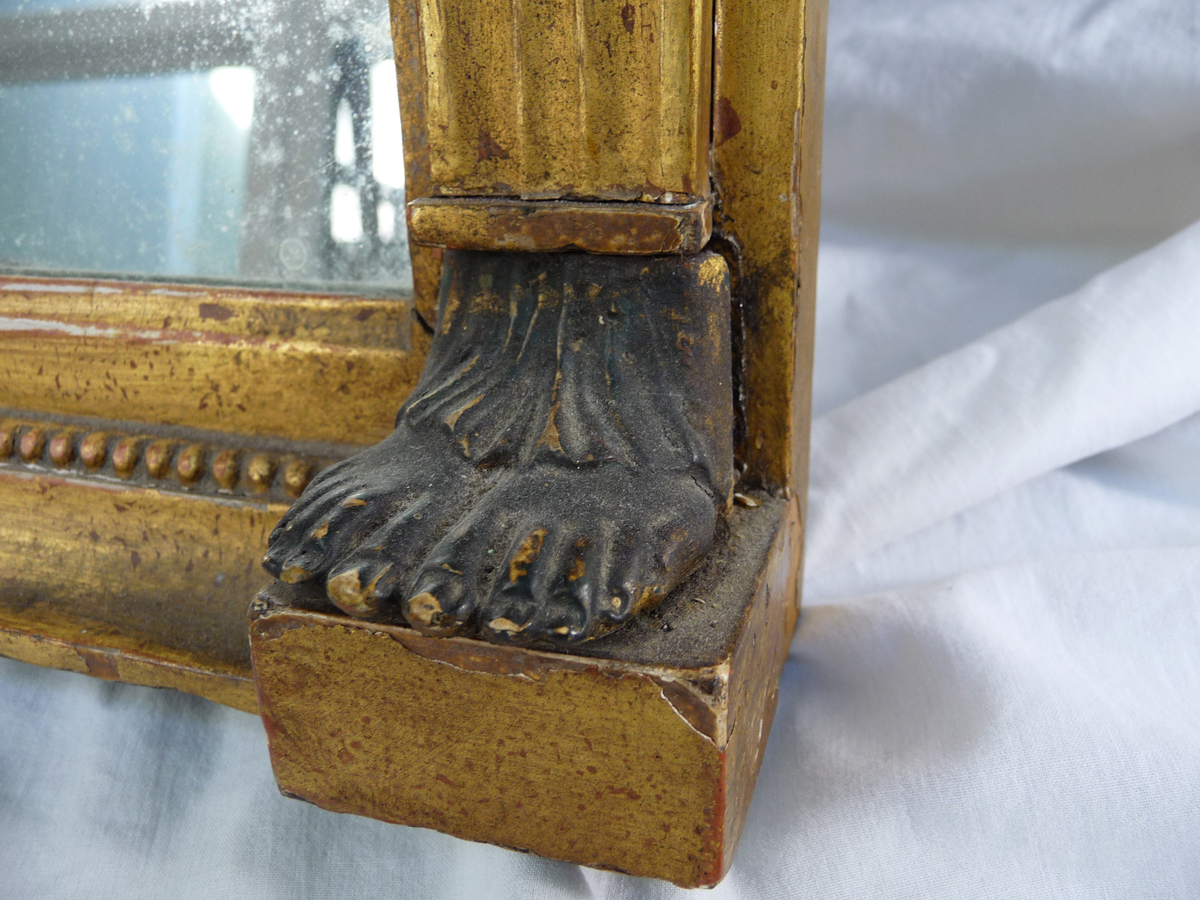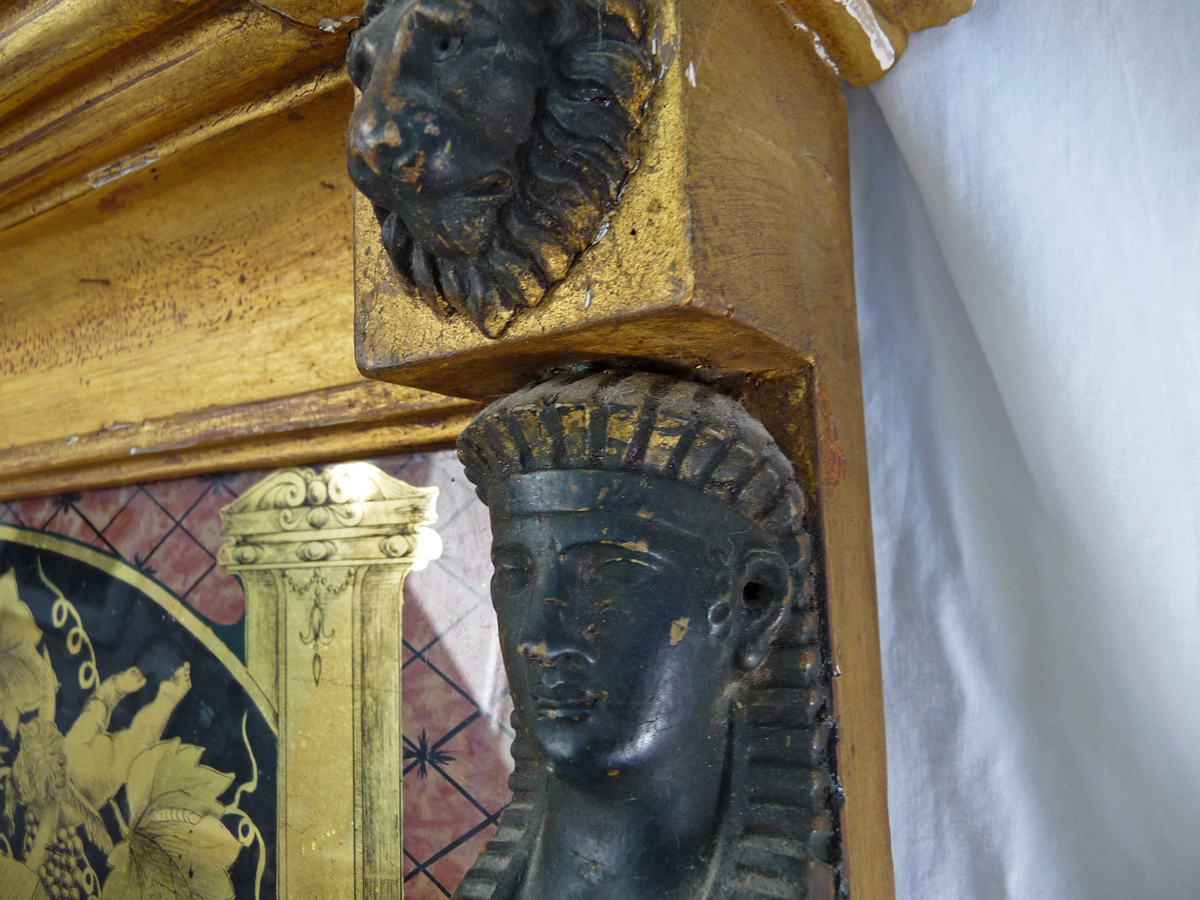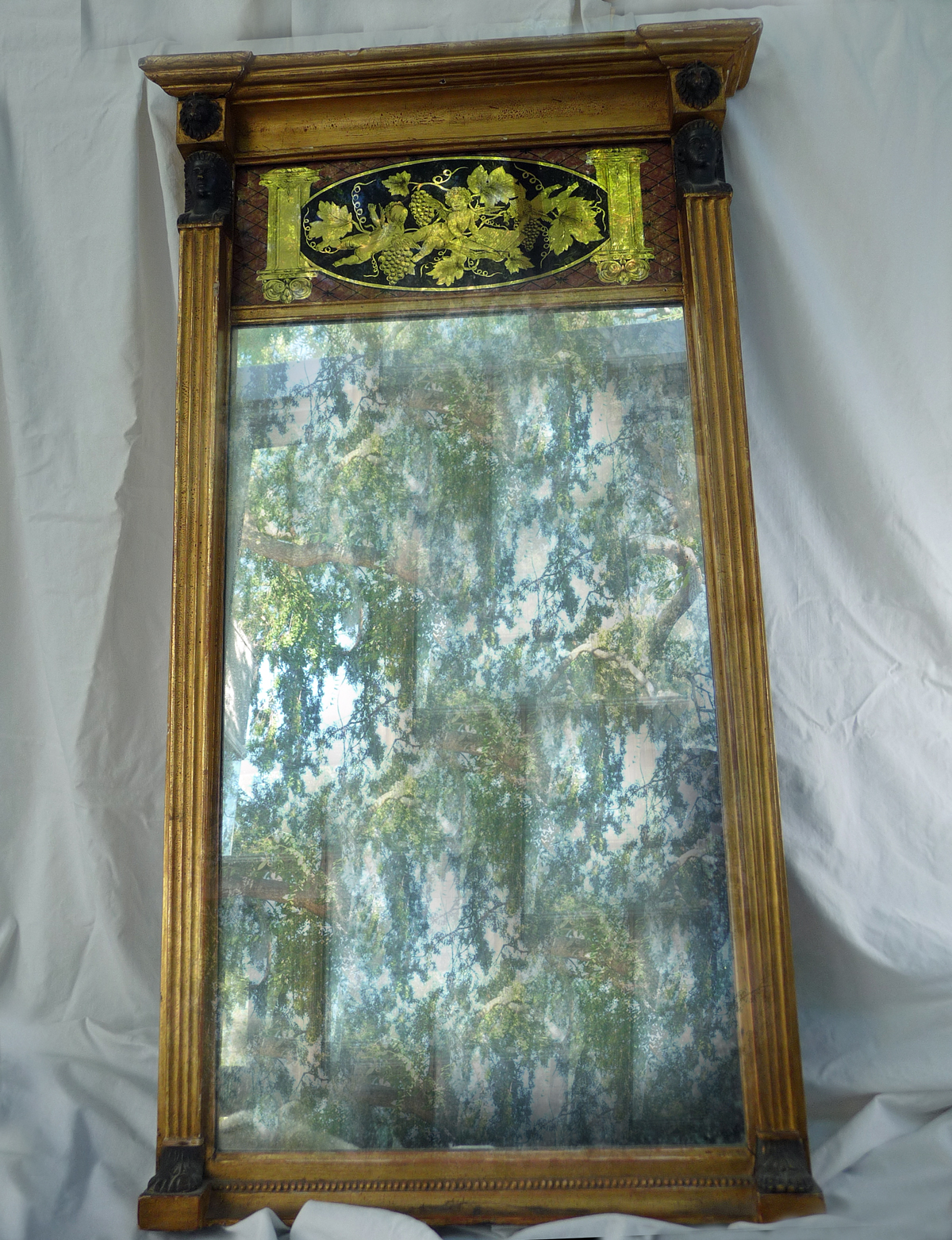My maternal grandmother lived in Longmeadow, Massachusetts. She furnished her house with Chinese snuff bottles, lamps made of Japanese dolls, and oyster silk bed-hangings. Many of her belongings had been acquired in travels with her second husband, the Austro-Hungarian named Rene. Everywhere the faint smell of Dior perfume, especially upstairs. Many things rustled.
Grandmama hung two things in her entry hallway. One, a set of harness bells on a leather strap to replace her doorbell. Any time someone rang, bells jingled.
Two, this mirror. To check hair, face, collar, before we left the house. You know, to make sure everything was “good-looking” enough.
When my grandmother died, my mother, uncle, and aunt, met at her house to divide the contents. The mirror wound up in my house, along with one silver bowl and several porringers, a few Chinese snuff bottles, those harness bells, two wooden chairs, and a wood frame bed. Apparently the mirror is from the Federalist period. But I don’t know anything more. Nor does my mother. Nor, even, does her highly efficient sister, otherwise known as Aunt Linda. The only appraisal the siblings did was for estate tax purposes, and as such, lacks detail.
High WASP family furniture is like that. Perhaps we’re not alone in the lack of detail, however it happens.
I looked up Federalist mirrors on eBay. This piece looks most like what I’ve got hanging in the small hall of my small California ranch house. So perhaps I’ve a mirror from the 1800’s. Perhaps made in Boston. In any case, it comes with sphinxes, lion’s feet and some very fiendish cherubs. I believe the photo will enlarge when clicked, for cherub-viewing.
I am enormously fond of this thing. I wonder how, if one’s grandmother didn’t happen to own anything similar, being perhaps neither the type for fiendish cherubs nor resourced accordingly, one might replicate the experience. Let us deconstruct. Much of my affection is easily come by:
- You can tell no machine put this thing together. Too many crooked noses. Artisans are on the rise in the Internet economy. Support them.
- I know where it came from, the mirror’s got more emotional history than “I went to Pottery Barn.” Which argues for house goods shopping in small stores, on Main Streets, on travels.
- It’s got some seriously quirky styling. Cherubs? And sphinxes? There’s something to be said for scattering one or two over-the-top pieces amongst one’s furniture.
- Antiques give a 1950’s California ranch house hope, if slight, of a style statement beyond, “And then many people moved to California so we built lots of identical little houses very quickly.” The first principle of High WASP decorating is Eclecticism. Necessity built the sensibility, but the sensibility became necessary.
- I actually like the Federalist period itself. I enjoy every era in which a society struggles to incorporate history. The Renaissance is another such. These mirrors can be obtained now, as antiques in places like The Federalist Antiques, and reproductions from, among others, The Federalist. Whereas I would not furnish a house house entirely in period antiques or reproductions, if you’re going for eclectic, I have no scorn for reproductions. Especially reproductions of a style that is so, um, stylistic. I’d love to see this in a modern glass house.
- The mirror belonged to my somewhat outrageous grandmother. The value is not all in affection, I admit. Grandmama could be difficult. But as I get older, I see my own story from more of a distance, and the places where mine intersects with the women in my family become clearer. Icons can be lifted from most families, and installed as reminders of us our particular task.
Finally, and more conflicted, I do derive some sense of identity satisfaction from my origin in a family of means. I confess. As though some of their glamor, and in particular the achievement that led to their means, rubs off on me.
What about family pride? Useful? Valuable, even? Certainly for a family just arrived from further shores, hustling in the American way to make good. So when that hustle happened a few centuries ago, how to recognize past generations’ accomplishments? Especially because, and here’s the rub, those accomplishments took place in a time when human rights were weak?
These days I’m in the mood to stay proud of past achievement and try to live a present of merit. A leavening of humility and constant intent. I take guidance from your comments here. Thank you. Let’s assume family pride can be a good thing.
Grandmama donated so much to charity that at her death, her children found bushels of letters from various causes, heaped on her desk, sofa, and office floor. Nobody’s perfect. You just have to keep on trying, and maybe leave a mirror. They make good legacies, as both furniture and metaphor. And metaphor is as helpful as duct tape, in a pinch.
I’m hoping someone here knows more than I about the piece itself. Fiendish cherubs and all.
Images: me




40 Responses
Another beautifully written post. I particularly like this:
“These days I’m in the mood to stay proud of past achievement and try to live a present of merit. A leavening of humility and constant intent.”
I can appreciate the artistry and the antiquity of the mirror. but more than that I love the fact that it is a family piece. It has the best provenance.
It’s beautiful, I used to write an antique column but can’t tell anything more than you’ve already said. I love inherited pieces and the sense of belonging they offer.
In addition to shopping on Main Street, shopping in second-hand stores is a lovely way to add a little flavor to one’s surroundings.
A dear friend who loves to go “junking” taught me a long time ago, “Heirlooms are in the eye of the beholder.”
Love your fierce cherubs!
I think family pride is a very important thing–no matter if you come from wealth or sturdy rural farming stock. I have a great deal of pride in the decency of my family. I think a sense of family history gives us identity.
This last weekend our daughter in law used colorful kitchen tablecloths which had belong to her great grandmother for a birthday party. These humble bits of kitchen kitsch give her a feeling of being connected.
Sorry, I cannot help you on this one. The mirror is a grand one. I appreciate the memories attached to it, memories for you. Were I you, I would not have it estimated, priced. I´d let it keep its secret!
I agree mostly on what you wrote, but not the part of reproduction. That is just me.
Lisa, it would be difficult not to be attached to that mirror. I love the mottled glass, the detail, and most of all, the emotional connection you have to it. Having something that belonged to an ancestor is a rare gift.
“The first principle of High WASP decorating is Eclecticism.” Thank goodness – there may be hope for my decorating style yet.
The mirror is truly fascinating, as is the history behind it.
If one is conscious, it can be difficult coming to terms with the past transgressions or even atrocities of one’s predecessors, against those of lower social standing and even sometimes against one’s family or oneself.
For me, understanding, as you clearly do, that two or more seemingly opposing realities can, and very likely usually do, exist within the same historical, physical, emotional space is almost worth the faded (in my case) family fortunes. In fact, I think this may be the beginning of wisdom.
I know not of the mirror’s heritage…it’s a wonderfully executed piece.
It does ones heart good to soak in all the details…I have looked long at this image and know it would hang proudly, a stand alone piece.
I would love to see the other things that you inherited from your grandmama.
I love the scents of Dior and the sounds of rustling…your words are so polished, yet honest.
This post reminds me of “Go Down, Moses” by Faulkner. Just the grappling of family history, the difficulty of incorporating a not-so-savory past with the present. His writing is focused on Southern families though, so it’s different.
I have a Victorian Art Nouveau cast metal jewelry casket that my (maternal) grandfather gave to my grandmother when they were very young in their marriage. It is one of my most precious possessions. It not only connects me to my family’s history, but it gives me a view of my grandmother at a time when she might’ve been young and hopeful and full of dreams, before life happened – a depression, a World War, and a disaster (she was a refugee of the Ohio Flood of 1937 – one of our country’s greatest natural disasters). I believe she suffered for the rest of her life from Post Traumatic Stress Syndrome, resulting in alcholism, and in emotionally cutting herself off from the rest of her family. When I look at that box, I wish I had known that young woman she once was.
Oh that mirror is a beauty! And yes, there is value in family pride. You recognize past generations’ accomplishments by enjoying the fruits of their labors, federal mirrors and all, and honoring their memories, values, and legacies.
Well timed post for me, though cannot help you re mirror’s era. Am divesting some family heirlooms now, feel pangs of guilt. Keeping what speaks to me, but to keep everything? No, just as I would not want my children to keep absolutely everything from our estate. It’s been hard to give myself permission to let go.
I think it’s great that you feel so strongly about the mirror. In an increasingly throw away culture, one has to wonder what the legacy left to future generations. Somehow “It was my Grandmother’s iPhone” doesn’t seem right, does it?
Lisa, I love this post. I feel proud of your family too. I also love the Federalist period, and well, the Federalists themselves.
The mirror is a treasure.
You know, our doorbell is broken and you’ve given me an idea for what we might do with our own set of harness bells on a leather strap :-)
such a beautiful piece! i really love that you have such a rich family-history-filled piece. the historian in me is always curious about the secrets and stories behind the furniture and jewelry and clothing that gets passed along for years and years.
Love the mirror and love mixing old inherited pieces with the new.
Hope some one in the know can give you the mirror’s history-it’ll be like an online episode of Antiques Roadshow x
Wonderful post, Lisa. I love the glass of that mirror, and the whole idea of glass being a liquid and growing mottled and reflecting history, and, well, as you said, a metaphor is as helpful as duct tape. In a pinch.
It is a most curious piece and I love the idea of it hanging in your home. We have been shopping new furniture for our bedroom, the last room in our home to have furniture we have mutually selected. DH and I are having a bit of a “spat” about the large mirror he wants to place in the new sleeping quarters. He thinks it will enlarge the room, but the room is already large and I have worked so hard to keep it simple. Blunty, the mirror he wants is KINKY! While a mirror of the type you have pictured is full of character and entirely appropriate to its setting.
My sister and I have inherited a number of antique pieces that came over from Australia after my grandmother passed away and we sold her (once her great-aunt’s) home there. I, too, take such pride in these peices, and look forward to the day when I own a larger home and can take the majority of the furniture out of storage.
Beautiful mirror, and I bet very beauiful in your home.
I think having a mix of new and old in a house gives it some sort of depth. The Farmer and I have some older items from both our families but particularly his. I like the knowledge that others have used them daily before us – it is kind of like walking where others have walked before you…
Federal, Empire, and Regancy rings this bell. Do a little research on the latter two and I think you will be pleased. I’ll have to go back, but it looks 18th century. Write Reggie Darling’s blog and tell him I sent you, he may have more for you. Ah! Waspy is the word, I have the same sentiments and a house full family furniture which unless burns to the ground, will never leave. Thanks for the wonderful post and reflection. I truly enjoyed the read.
This is such a beautiful post but I have to admit that my favorite line is “And metaphor is as helpful as duct tape, in a pinch.” I am taking that one with me when I go and I am holding on to it. I promise to quote you when I use it.
Wonderful post, Lisa, and Lovely mirror! Family pride can warm like a security blanket I have found. As I get older and more and more of my family are gone, my pride in who I am is very consoling. It’s nice to be proud of who we are. Those items that are left to us serve as a concrete symbol of that pride, I think. They are also very comforting. xoxo
Enjoy reading your thoughts and all the comments almost as much!
The mirror is wonderful, as are your thoughts. Family possession do connect us to our past and our ancestors. It’s why I keep my grandmother’s “Chinese bowl” (actually from Stoke-on-Trent) on display in my dining room. Oh, and how lucky for you to own a Federal piece, from one of the most beautiful of design eras, in my opinion.
i’m glad that you have kept it quite well. you can pass it down to your kids next and hope grandmama’s mirror stays in the family for a long time. :)
Hello Lisa:
From the looks of it you, indeed, have a very fine Federal-era period mirror (not “Federalist” but rather “Federal”). I agree, it has the hallmarks of Boston, and certainly was made in a sophisticated city/urban center vs. regional/provincial one–nothing “country” about it. The sphinx and foot detail are unusual and very sophisticated, and the quality of the eglomise is exceptionally high. This was an expensive mirror when made, and I would give the quality as a superior on the Sack scale of good/better/best/superior/masterpiece. In other words, a very good mirror, indeed. The only thing limiting its quality is that it is not bigger, with more panels, for it is a pier mirror as opposed to an overmantel, which is the most desirable form. If it is not Boston, then I would suspect it is English, which would make it Regency, as opposed to Federal, as Kevin from Hollywood suggests. If it is American made it is much more valuable than if it were English, given the rarity. A lot of mirrors were imported during the period. In order to have a more definitive view, I’d need to see a close up of the eglomise panel, which appears to be of such high quality as to potentially be English, rather than American. Have you checked the back of the mirror to see if there is a label? Also, does it have its original back boards? You want to have the original wood panel backboards, if possible.
Whether American or English, you have a lovely mirror, and one of very fine quality. Do not “freshen” up the gilding or replace the mirror plate, as it would substantially impair its value and/or desirability to collectors. Best to leave it alone, except for the occasional dusting. Reggie
Oh, and one other thing to note. Given the presence of the Sphinxes, I would date this to 1805-1815, which is when Egyptian motifs were in vogue, due to the Napoleonic explorations there, which excited tremendous interest in Egyptian decorations, at least in sophisticated urban centers. But this is not a purely or strictly Egyptian inspired piece, which argues for American origin vs. English, which would have been stricter in its interpretation with an Egyptian-inspired eglomise panel as opposed to what you have on your mirror. RD
What a lovely post and a beautiful mirror as well. I treasure those few family pieces that did pass my way, and they remind me of my families past and their accomplishments and failures as well as how my own hopes and dreams and successes fit into this chain. Is it not fitting that you have a mirror from this aunt? And I personally embrace eclecticism and think that a federal mirror in a California ranch house seems to embody the best of integrating one’s self and one’s accomplishments with the whirling ether out of which one arrived. None of us come newly minted from Pottery Barn, after all, although perhaps there are moments when we might wish we did.
Belle – Thank you. Provenance indeed:).
Tabitha – You used to write an antiques column? Wow. No wonder you’ve got those great chandeliers!
Rubiatonta – I know some people just live for second-hand stores, and I imagine one can find good stuff too. I’d probably want to educate myself about so much first.
Susan – I love the idea of kitchen tablecloths used for generations. Heck, most of us were sturdy rural farming stock at one point or another. At least in the US.
mette – Yes, I will probably not have it appraised, at this point, since I plan to just let it sit on my wall.
Charlotte – I feel very fortunate.
Jan – Just be on the hunt for some cherubs, right?
Ann – “…seemingly opposing realities can, and very likely usually do, exist within the same historical, physical, emotional space is almost worth the faded (in my case) family fortunes. In fact, I think this may be the beginning of wisdom.” Well said. I think I hold so strongly to an And Model Of Identity precisely so as not to have to chuck any reality out the window.
Hostess – At your command! I will do a Grandmama roundup, at some point. Thank you for your kind words.
Danielle – I will take that as a wonderful compliment. Thank you. The High WASP diction is very different from the Southern Gothic, or whatever we ought to call Faulkner.
Lara – That paints such a vivid picture, the young woman, the Ohio Flood, the casket, the alcoholism. Thanks.
Stephanie – Yes, I also prize the values as much as the fruits of the labors.
Duchesse – Oh there’s so much that can be let go. On the other hand, maybe your sons would want to talk about it too, have a bit of a say, if that’s possible.
James – Ha! There is something about the clear handmadeness of the mirror that particularly endears me to it. Can’t say that about my phone:)
Susan – Thank you! The harness bells do make a lovely sound. Perhaps it was meant to be.
miss sophie – And of course I don’t even know who made this…
FF – Read on! Reggie came through, of course:).
Town and Country Mom – Mirrors can be such over-obvious metaphors, but as you point out, so useful in so many ways. Again, like duct tape:).
Terri – Ha! But I dunno, a mirror with cherubs flying around it and looking at you is kind of kinky, no?
Princess Freckles – Oh how fascinating. I keep trying to the the Australian blogging sorts to tell me about their High WASP equivalents, but they say they don’t really have them, except the people who had ranches. I would love to see what sort of antiques Australian produces.
A Farmer’s Wife – It is a good way to keep one’s life layered well.
Hollywood Forever, Kevin – Well hello! Did you know, I had already asked Reggie! Great minds think alike. And thank you for the kind words. Nice to see you here.
La Belette – I’d be honored. MORE than honored.
Preppy 101 – That’s a very perceptive statement – things we might have been a little proud of before do become more like comfort as we get older.
Heather Chappie – Thank you very much. The comments here are always great.
SewingLibrarian – A “Chinese” bowl from Stoke-on-Trent! One can’t make these things up. How wonderful.
Ash’s Mim – Absolutely.
Reggie – He’s here! Yay! Thank you SO MUCH. No label on the back, only a chalk marking that says 177/177 and that could have been from the move from Grandmama’s house. The board behind the eglomise (new word!) appears to be original. I can’t say about the board behind the mirror. The nails used on both look to be hand made, but I’m a bad judge. The cherubs are reading a book, and floating through grapes, and have odd hands:). Not pure Egyptian at all! No freshening will be done, I promise. Thanks also for the likely dating. You are a gentleman and a scholar.
Mardel – Thank you. “None of us come newly minted from Pottery Barn, after all, although perhaps there are moments when we might wish we did.” Ha! I’ll take the new Spring me, please?
It certainly looks European Empire period to me. French or Italian workshop — I really don’t think of it as English in style. I would see about any regional workers who were known during that time in Milan… however, it is just over the top enough to possibly have originated in American Federal period and then been added/embellished to in the late 19th century.
And as a side note, I’ve already inherited some fourth+ generation pieces from my Grandmama of her mothers, etc. I’m the second-eldest grandchild but the only one with an established home. The things I have I know I will cherish for years. Mostly as a source of family pride.
Have you ever considered publishing an ebook or guest authoring on
other blogs? I have a blog centered on the same ideas you discuss and would really like to have you share some
stories/information. I know my audience would enjoy your work.
If you are even remotely interested, feel free to send me an email.